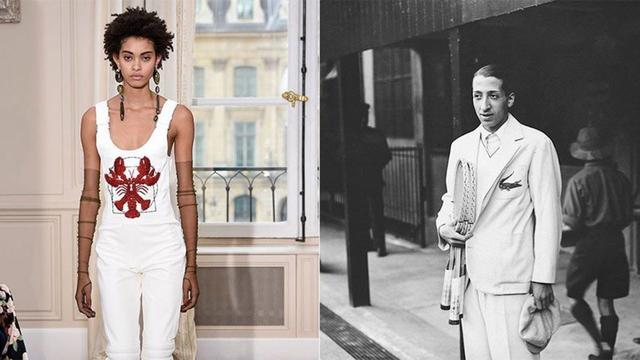
There is no brand that does not have recurring elements: Chanel camellias symbolize the savoir faire of the French house or, for example, the goddess Medusa that stars in the Versace logo and that Gianni himself chose to represent that strong and powerful woman. whom he wanted to dress with his creations. Fashion has always been full of symbolism and, if there is something that has been repeated throughout history, it is the continuous reference of some brands to certain animals: Schiaparelli's lobster, the bee among Dior's embroideries and patterns. .. And, yes, all of them have an explanation behind:
References to the surrealist movement have been a constant in Schiaparelli's creations. Transferring the brushstrokes of Cocteau or Dalí from canvas to canvas was a common practice in the house during the 30s of the last century, the brand's heyday. Curiously, her friendship with the Catalan artist led her to use one of the most recurrent elements of her work on more than one occasion: the lobster. In 1934 Dalí began to fantasize about this crustacean, and he let his friend know in a letter. Just three years later, the lobster dress already existed, an evening garment made of white organdy and with this animal print.

Since then, there have been many occasions on which the brand has used lobster. One of the last was in the spring-summer 2017 Haute Couture collection, created by Bertrand Guyon and with which a tribute was paid to the most personal part of its founder through embroideries and brilliants in dresses, jackets and jumpsuits.
Beyond its logo (a steed pulling a carriage), the horse has been closely linked to the Hermès house since its origins: Thierry Hermès founded a business of harnesses and leather products for horse riding in 1837 at a time when this animal was the main means of transportation. Surely that young man who revolutionized the market with a mold that fit the horse's neck (and for which he was awarded the First Class Medal at the Universal Exhibition in Paris) did not even remotely imagine that his house would become, years later, in one of the epitomes of world luxury.
The return to the horse in Hermès supposes a return to its origins, a way of delighting in its own existence. This animal now bathes handkerchiefs, charms, bags and all kinds of prints. The figure of the reinvented Amazon has also been common in his designs ever since.
The New Look silhouette, the Oblique print, the famous Bar jacket... Dior has a series of garments and motifs that, turned into emblems, are rescued from time to time from its archives to adapt to the present. In animal terms, one of his constants has been the bee, the imperial insect that Napoleon himself used to decorate his clothing and flags and that over time has become a symbol of power and aristocracy.
The origin of this relationship lies in the passion that Christian Dior felt for gardening. When he decided to create his brand, he contacted a well-known publicist who, based on the creator's tastes, designed a logo with this animal as the protagonist. Although in the end a more minimalist logo was chosen than the initial one, the bee was kept in his archives and has been rescued by his successors in many of his collections. The arrival of Maria Grazia Chiuri (the first woman at the head of the house) has given it a new connotation: that of the queen of the swarm, one more way of representing female empowerment.
The origin of one of the most repeated motifs in Lacoste (and which, moreover, stars in its logo) is simple and plain: the founder of the brand, René Lacoste, was a prestigious tennis player who, perhaps because of his speed with the racket, he was baptized by the sports journalists of the time as 'the crocodile'. In full development of his brand to practice this sport, he decided to make it his logo. Years later, all the garments have a crocodile embroidered on the chest, a motif that, on several occasions, he has also used as a print.
The case of the American firm deserves a separate mention. Although there is no relationship in the most literal sense, if you have a pair of jeans or a jacket from the brand hanging in your closet you will have noticed that on its leather label there is a red engraving in which two horses, harangued by their owners, pull on some pants. Purpose? Show that this tissue was so strong that not even these two animals could break it.